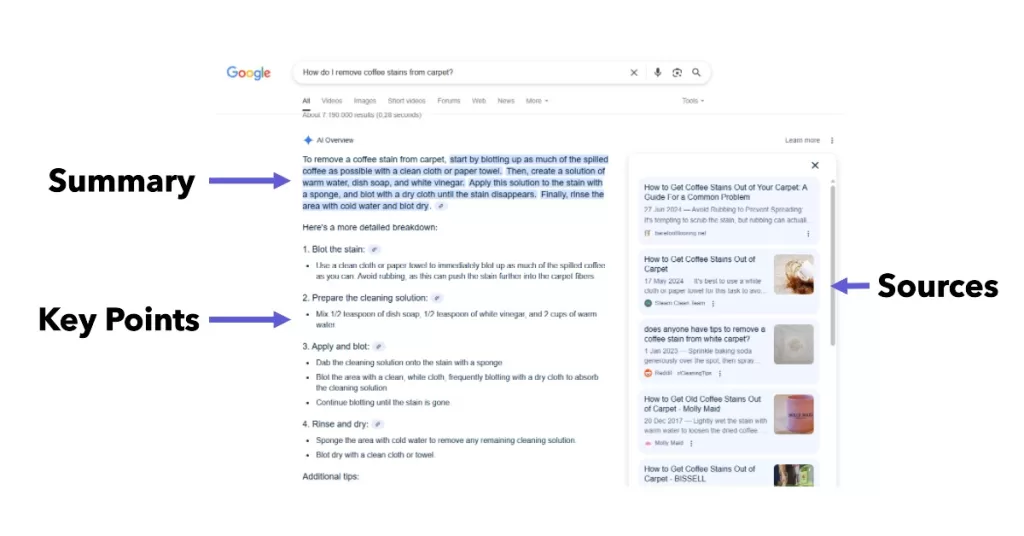In 2024, Google rolled out one of the most transformative updates to its search experience since its inception: AI Overviews. As part of Google’s broader Search Generative Experience (SGE) initiative, AI Overviews mark a significant shift toward a more intelligent, conversational, and generative search experience.
Instead of a list of blue links, users now see AI-generated summaries that pull together information from across the web. These summaries aim to answer complex questions more efficiently, offering users quick, summarized insights without requiring multiple clicks.
For marketers, SEOs, and advertisers, understanding AI Overviews isn’t optional. It’s the key to staying visible and competitive in a SERP environment increasingly powered by generative AI.
1. What is Google AI Overview?
Google AI Overview is a generative AI feature in Google Search that provides quick, short answers to complex user queries. It’s designed to help users quickly understand a topic without clicking through a dozen articles.
Think of it as the evolution of Google’s featured snippets, but with a deeper, more conversational twist. It’s part of what Google calls the Search Generative Experience (SGE).
Rather than simply surfacing the best content, Google now wants to generate the best possible answer based on its understanding of the query and the web.
Key Characteristics:
- Launched broadly in 2024, initially in the U.S., with international rollouts expected.
- Built on Gemini, Google’s powerful family of generative AI models.
- Designed to improve user experience by reducing friction in the search journey.
As Google packaged it, the goal is to help users make sense of complex topics without needing to click multiple links. That means less hopping from site to site, and more answers, faster.

2. When and Where Does Google AI Overview Appear?
AI Overviews don’t appear for every query. In fact, Google has been quite cautious about when they trigger, especially in sensitive or regulated spaces.
The feature tends to appear in response to complex, multi-part queries that require synthesis, nuance, or planning.
These include:
- How-to questions: “How do I remove coffee stains from carpet?”
- Planning queries: “Best family vacation spots for toddlers in Europe”
- Comparisons: “Yoga vs Pilates for lower back pain”
They typically don’t show up for:
- YMYL (Your Money or Your Life) queries. These include health, finance, and legal topics.
- Queries with an obvious or factual answer (e.g., “weather in Boston today”).
According to Botify, AI Overviews appear in about 59% of searches with informational intent and for 19% of searches with commercial intent. However, this number is expected to grow as Google refines its confidence thresholds.
Bottom line? Expect AI Overviews when:
- The query is open-ended or multi-faceted
- There’s no single, definitive answer
- Google sees an opportunity to reduce user effort
3. How Does Google AI Overview Work?
Under the hood, Google AI Overviews are powered by Gemini, Google’s large language model (LLM). But unlike ChatGPT, it doesn’t pull from a live web crawl. Instead, it generates responses based on Google’s indexed content, synthesizing insights across multiple sources.
This is important: Google isn’t just quoting web pages. It’s creating new summaries based on what it deems the most reliable, relevant content.
How It Cites Sources
AI Overviews typically include source links, but the placement and visibility vary. Sometimes they appear as footnotes; other times, they’re embedded inline.
Here’s the kicker: According to Search Engine Journal, 43% of AI Overview links point to Google’s own properties like YouTube, Maps, and even other SERP features.
That means:
- Organic competition is tighter
- Your content needs to be more structured, authoritative, and helpful to be cited
- Even if your site ranks well, you might be bypassed in favor of Google-owned content
Optimization Tip:
Pages with clear markup (like FAQ, HowTo, and Product schema) and structured, scannable layouts are more likely to be used as sources.
4. How Will AI Overviews Change the Way People Search?
We’re entering the age of intent-based, conversational search. Instead of typing keyword strings like “best hiking boots waterproof men,” users are now asking full-sentence questions like:
“What are the best waterproof hiking boots for men with flat feet under $200?”
And AI Overviews are rising to the occasion with synthesized, multi-source answers.
This shift brings three big changes:
- Fewer clicks: Users can get what they need without visiting multiple websites.
- Higher expectations: Searchers expect fast, chat-like responses.
- Decline of traditional blue links: Organic listings are pushed further down.
As Google positions itself as a “smart assistant” rather than a directory, businesses need to rethink how they structure content and capture intent.
5. What This Means for SEO and Content Creators
If you’ve been focused solely on ranking #1 in the SERP, it’s time to rethink your strategy. AI Overviews are changing what it means to “win” in search.
What You’ll Notice:
- Decreased organic clicks for certain query types, even if your content is high-ranking.
- A higher value placed on topical depth, authoritativeness, and semantic relevance.
- Pages that are clear, structured, and well-optimized have a better shot at being cited.
Recommendations for SEOs:
- Add structured data (FAQ, HowTo, Product schema) to guide AI models.
- Emphasize first-party expertise. Authentic, experience-based content is harder to replicate.
- Monitor impressions vs. clicks in Google Search Console to gauge AI Overview impact.
As Google continues to lean into generative AI, EEAT signals will carry even more weight. Don’t just optimize for bots, optimize for answers.
6. What This Means for Google Ads and Advertisers
Let’s be clear: Ads still show up in SERPs with AI Overviews. Typically above or below the generated content.
But the visibility dynamics are changing.
Here’s what advertisers need to watch:
Increased Scroll Depth
If users engage heavily with AI Overviews, they may scroll less or more, depending on intent. For some queries, this means ads might get buried beneath the fold.
New Ad Formats Are Coming
- AI-powered Shopping Ads that generate summaries and suggestions
- Conversational ad experiences, similar to Performance Max
- Generative ad creatives that adapt based on user queries
Strategic Shifts to Consider:
- Broader match keywords may perform better as queries get longer and more conversational
- Invest in brand awareness to stay top-of-mind even if organic presence shrinks
- Monitor CTR and CPC fluctuations and test new copy formats that align with user intent
7. Final Thoughts: How to Stay Ahead
Google’s AI Overviews aren’t a passing trend. They’re the new normal. And this isn’t just a cosmetic update. It’s a paradigm shift in how search works, how users engage, and how marketers must respond.
Action Steps to Prepare:
- Conduct an SEO audit with a focus on structured data and content depth.
- Re-evaluate paid search strategy to account for changing ad visibility and user behavior.
- Use tools like Ahrefs, Botify, and Search Console to identify content cited in AI Overviews and optimize accordingly.
Being cited in an AI Overview might not always lead to a click, but it will boost visibility, trust, and brand recognition. And in this new search landscape, those signals matter more than ever.
Conclusion
Google AI Overviews are redefining how people discover information and what it takes to stand out. They blend the power of generative AI with the trust of Google’s search ecosystem, creating a faster, more curated user experience.
For SEOs, content creators, and advertisers, the implications are clear: adapt, or fade into the scroll abyss.
The good news? You don’t need to overhaul everything. But you do need to be smart, proactive, and relentlessly helpful.



